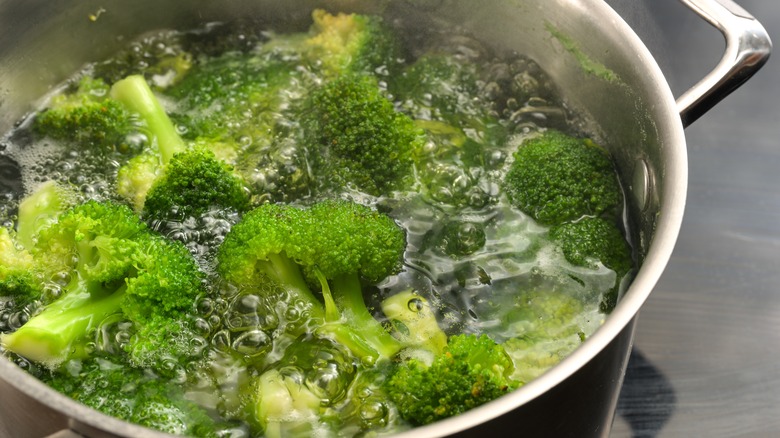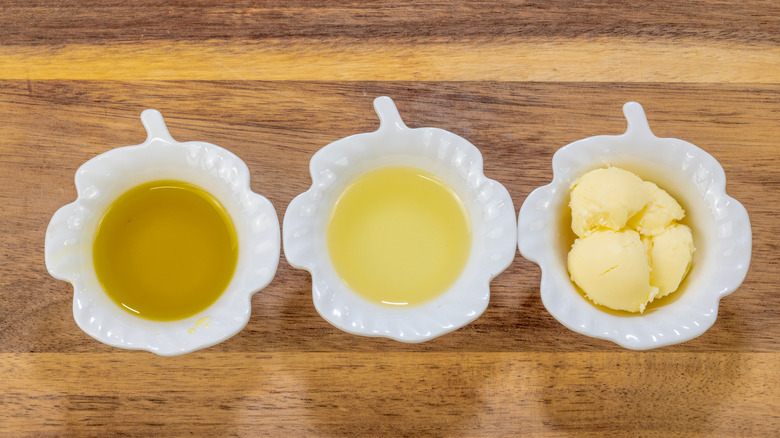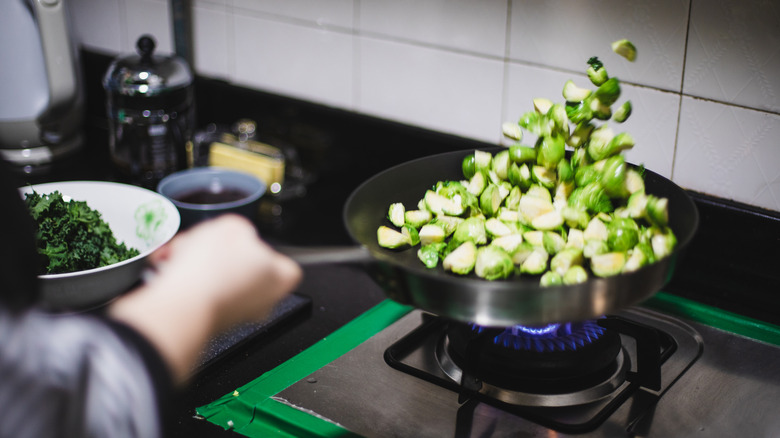The Step You Need To Take Right After You Blanch Those Greens
Tender green vegetables and blanching are best friends. Not only does a quick bath in hot water punch up the bright green color of veggies like green beans, asparagus, broccoli, and snap peas, but it's also a gentle method of cooking that will retain lots of nutrients. But have you ever blanched a batch of haricot verts only for them to turn gray and wilt a few minutes later? The problem is carryover cooking. When the vegetables are pulled out of the boiling water, they're still hot enough to keep cooking and steam continues to escape unless you douse them in an ice bath to stop the cooking process. But if your recipe calls for hot vegetables instead of cold ones, toss them directly into some fat right after they come out of the blanching water.
A layer of fat will stop steam from escaping from blanched vegetables, which will keep them looking bright and crisp. All you need to do is toss your veggies with some melted butter or olive oil in a bowl and serve. Or, you can also blanch the vegetables and then finish them in a sauté pan.
Have some fat ready before blanching
If you like to cook and eat fresh food, by now you probably already know that blanching is the surefire way to guarantee vibrant vegetables. Just drop your fresh veggies in boiling water for five minutes or less and they'll be cooked but still crunchy, plus their natural colors will pop. What happens is the hot water breaks down a fine layer of gas on the surface of the vegetables, which reveals their brightest colors. The trick to keeping that nice color intact, according to acclaimed food scientist Harold McGee in his book "On Food and Cooking," is sealing the outside of the vegetable with fat so the steam can't escape.
Try to stick to fats that complement the flavor of your vegetables. For example, the grassy flavor of asparagus and green beans will taste great with extra virgin olive oil (avoid regular olive oil, which is made with harsher pressing methods and doesn't have as much flavor). Earthier items like carrots and corn taste better with butter. Remember that blanching happens fast, so have a bowl with some butter or oil ready before you drop the vegetables into the boiling water.
Blanche and sauté
There are times when blanched veggies could use a little more cooking time, a little more caramelized color, or both. Have it both ways by tossing your blanched vegetables into a sauté pan with the fat and then giving everything a few minutes to cook and get crisp. This is a great method for bulkier veggies like broccoli and thicker green beans so they're brightly colored but not undercooked. Have a sauté pan prepared before the vegetables are dropped in the blanching water. When they're ready to come out, shake the extra water off in a mesh strainer over the sink, and then it's off to the sauté pan.
It's also perfectly fine to skip an extra pot altogether and do the blanching and sautéing in the same pan. This is a little bit like steaming (though there are important differences between blanching and steaming), but works just as well. Just fill the pan with about an inch of water, give the veggies a quick dip until they're bright, then drain the water. Next, add fat to the pan and toss the veggies over high heat until they look cooked and are ready to serve.
Keep the combination of blanching and fat in your back pocket anytime you want crisp, lightly-cooked veggies. As long as you have some fat ready to go when the food is hot, your blanched vegetables will always look fresh and colorful on the plate.


